| Vintage Pulp | Jan 23 2022 |

Damn it feels good to be a gangsta.
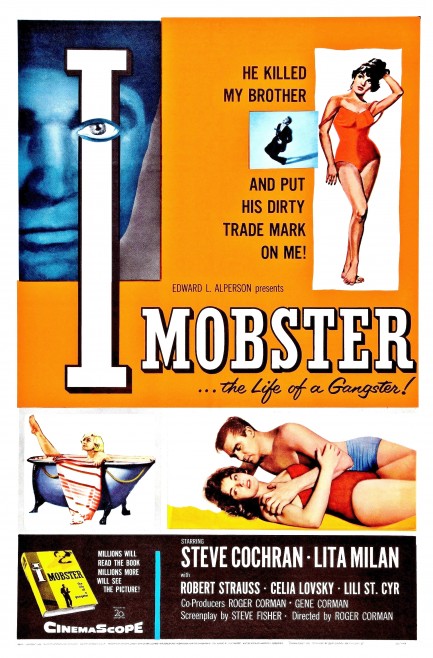
Above you see a U.S. promo poster for the crime drama I, Mobster, starring Steve Cochran in a rags-to-riches, innocence-to-corruption tale of a neighborhood kid who becomes a top man in the mob. The film was based on a 1951 novel of the same name published anonymously, but later identified as coming from the typewriter of Joseph Hilton Smyth, who also wrote Angels in the Gutter. The early plot driver is the mob's attempt to extort cash payments out of a powerful trade union. The plan is to offer services as “outside labor relations experts.” Cochran, as an ambitious footsoldier, expands the mob's vision, its areas of interest, and its profits. Pretty soon he's riding high, high, high. But it can't last. Of course not.
The film has the usual elements from this sub-genre: the round-the-way girl who offers redemption, the wailing mom who implores her son to go straight, the unimpressed father who eventually disowns him, the mob boss who's worried about his brash number two, and the ticking bomb—i.e. the seeds of destruction planted earlier. Here it's a little boy who knows Cochran killed a man. He grows up and becomes enfolded in the mob too, which places him in perfect position to blackmail Cochran. But Cochran is a tough cookie. It may take more than an ambitious twenty-something to bring him down, and it may be that the true seeds of destruction were planted earlier and elsewhere.
While the plot elements may be typical, the cast isn't. Cochran is a good, intense, underrated screen presence. Robert Strauss is perfect as Cochran's right hand man and steadying influence. The radiant Lili St. Cyr spices up the proceedings midway through with a burlesque routine. And the stunning Lita Milan is excellent as the good girl-turned-mob moll. In addition, the film is solidly directed. You often see I, Mobster, described as an early Roger Corman movie. Does a director's twentieth movie count as early? Corman knows what he's doing here. His road forked into the dark woods of schlock, but helming this production, with a low budget, he managed to squeeze out a solid b-mobster flick. There's nothing fresh in it, but with this cast freshness isn't needed. I, Mobster premiered today in 1959.
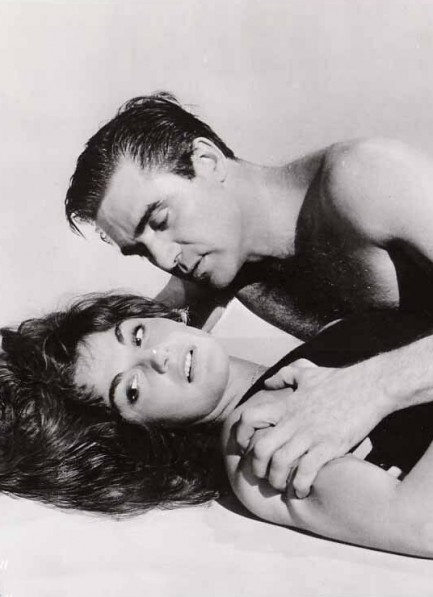 Don't play coy, baby. Would you rather be with a gangsta like me or some accountant from fuckin' donkeyville?
Don't play coy, baby. Would you rather be with a gangsta like me or some accountant from fuckin' donkeyville? That's what I thought.
That's what I thought.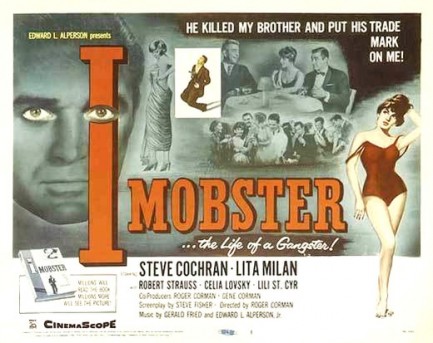
| Vintage Pulp | May 19 2018 |

It's a man's man's man's world. Until now.
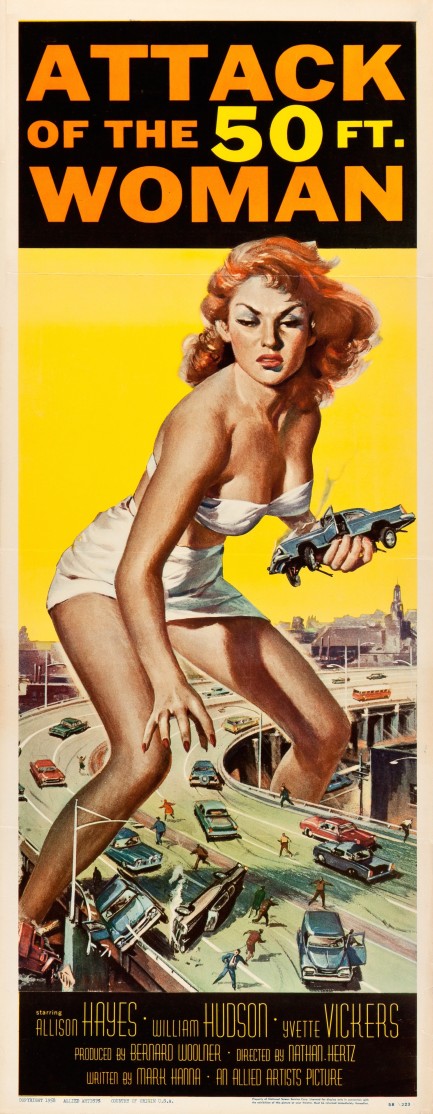
It was inevitable. You can't have a pulp website and not talk about the iconic GGA-influenced poster for Attack of the 50 Foot Woman. This masterpiece came from the brush of Reynold Brown, who also painted promos for Creature from the Black Lagoon, Spartacus, Ben-Hur, and—ironically—The Incredible Shrinking Man. But 50 Foot Woman is the one people remember. It's the one that appears on t-shirts, lithographs, refrigerator magnets and spoof posters to this day. And for good reason. It's a perfect promo piece, from the execution, to the chaotic scene depicted, to the giant's straddle-legged pose that titillatingly suggests the world's most shocking upskirt shot. It also makes the film look far better than it is. You'd never think the 50 Foot Woman of the poster is, onscreen, mainly a big foam hand and some weak projection work.
The movie premiered today in 1958. It was directed by Nathan Juran under the pseudonym Nathan Hertz, and while it's mediocre it isn't close to being one of the worst films of the period. People remember 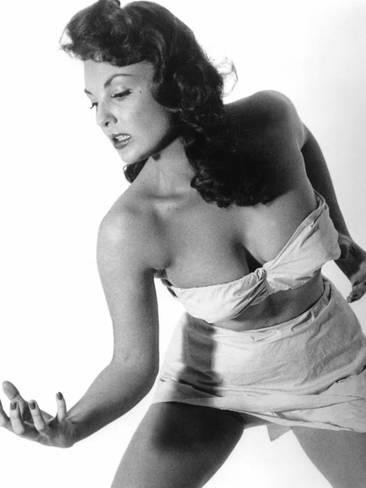 it because of Allison Hayes' character, an unhappy wife whose growth into a giant gives her all the physical power she could ever want, but none of the emotional strength she needs to deal with her philandering husband Harry.
it because of Allison Hayes' character, an unhappy wife whose growth into a giant gives her all the physical power she could ever want, but none of the emotional strength she needs to deal with her philandering husband Harry.
 it because of Allison Hayes' character, an unhappy wife whose growth into a giant gives her all the physical power she could ever want, but none of the emotional strength she needs to deal with her philandering husband Harry.
it because of Allison Hayes' character, an unhappy wife whose growth into a giant gives her all the physical power she could ever want, but none of the emotional strength she needs to deal with her philandering husband Harry. She's desperately in love with him, though he's a heel. When she eventually hunts him down the film becomes a feminist parable. We don't think that aspect was intentional, but it's definitely there by virtue of a male screenwriter creating a colossal feminine problem then determining how his male characters react to her. Guess what? She's fifty feet tall and still can't break through the glass ceiling.
The 50 Foot Woman has the power to deal with dirty Harry in a way he understands—dominance. Good. But she's also mad as hell and has busted out of her social niche. Bad. There's no attempt to reason with or negotiate with this newly empowered woman. Because she brings upheaval to the world elimination is the only solution. Yes, this movie has almost everything—an examination of gender roles as they relate to money, a discussion of emotional violence within marriage, and ruminations about male privilege. The one thing it doesn't have is a budget—for efx, good actors, multiple takes, or anything else. But that's why it's so endearing. Like the random growth spurt central to the plot, everything significant about Attack of the 50 Foot Woman is a total fluke.

| Vintage Pulp | Apr 24 2016 |

Anything for a thrill.
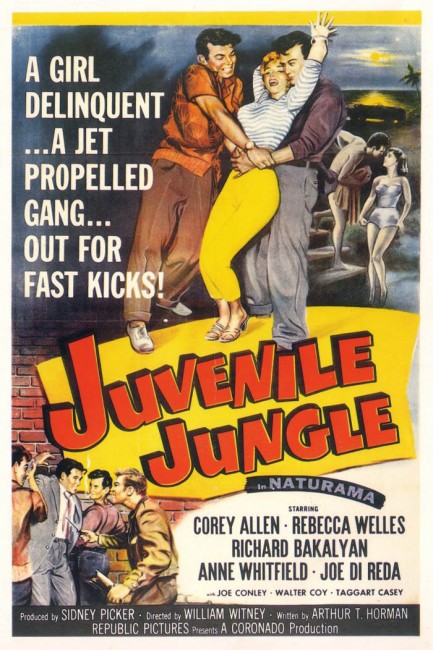
Awesome pulp style poster for Juvenile Jungle, with Corey Allen, Rebecca Welles and a brief appearance from Playboy playmate Yvette Vickers. The movie premiered today in 1958 and is one of the rare U.S. films we've been unable to find. But reviews are copious, and they'll inform you this revolves around a gang that kidnaps a store owner's daughter in order to extort his payroll, and how the plan goes awry when the gang leader and the captive fall for each other. Stockholm Syndrome in Southern California's beachside, leather-jacketed delinquent culture, filmed in the widescreen process Republic Pictures called Naturama.




































































